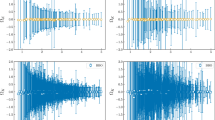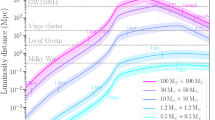Abstract
In this paper, we quantitatively discuss the impact of the current uncertainties in the even zonal harmonic coefficients J l of the Newtonian part of the terrestrial gravitational potential on the measurement of the general relativistic Lense–Thirring effect. We use a suitable linear combination of the nodes Ω of the laser-ranged LAGEOS and LAGEOS-II satellites. The one-sigma systematic error due to mismodelling of the J l coefficients ranges from ~ 4% for the EIGEN−GRACE02S gravity field model to ~ 9% for the GGM02S model. Another important source of systematic error of gravitational origin is represented by the secular variations j l of the even zonal harmonics. While the relativistic and J l signals are linear in time, the shift due to j l is quadratic. We quantitatively assess their impact on the measurement of the Lense–Thirring effect with numerical simulations obtaining a 10−20% one-sigma total error over 11 years for EIGEN-GRACE02S. Ciufolini and Pavlis (Nature 431:958–960, 2004) claim a total error of 5% at the one-sigma level.
Similar content being viewed by others
References
Ashby N, Allison T (1993) Canonical planetary equations for velocity-dependent forces, and the Lense–Thirring precession. Celest Mech Dyn Astron 57:537–585
Bianco G, Devoti R, Fermi M, Luceri V, Rutigliano P, Sciarretta C (1998) Estimation of low degree geopotential coefficients using SLR data. Plan Space Sci 46:1633–1638
Cheng MK, Tapley BD (2004) Secular variations in the low degree zonal harmonics from 28 years of SLR data. American Geophysical Union, Fall Meeting 2004, 2004AGUFM.G31C0801C
Cheng MK, Shum CK, Tapley BD (1997) Determination of long-term changes in the Earth’s gravity field. J Geophys Res 102:22377–22390
Ciufolini I (1996) On a new method to measure the gravitomagnetic field using two orbiting satellites. Il Nuovo Cimento A 109:1709–1720
Ciufolini I, Pavlis EC (2004) A confirmation of the general relativistic prediction of the Lense–Thirring effect. Nature 431:958–960
Ciufolini I, Pavlis EC, Chieppa F, Fernandes-Vieira E, Pérez-Mercader J (1998) Test of general relativity and measurement of the Lense–Thirring effect with two Earth satellites. Science 279:2100–2103
Cox C, Chao BF (2002) Detection of a large-scale mass redistribution in the terrestrial system since 1998. Science 297:831–833
Cox C, Au A, Boy J-P, Chao B (2003) Time variable gravity:using satellite laser ranging as a tool for observing long-term changes in the Earth System. In: Noomen R, Klosko S, Noll C, Pearlman M (eds) Proceedings of 13th International Laser Ranging Workshop, NASA CP 2003-212248, NASA Goddard, Greenbelt. Preprint http://cddisa.gsfc.nasa.gov/lw13/lw_proceedings.html#science
Cugusi L, Proverbio E (1978) Relativistic effects on the motion of Earth’s artificial satellites. Astron Astrophys 69:321–325
Dickey JO, Marcus SL, de Viron O, Fukumori I (2002) Recent Earth oblateness variations: unraveling climate and postglacial rebound effects. Science 298:1975–1977
Everitt CWF, Buchman S, Debra DB, Keiser GM, Lockhart JM, Muhlfelder B, Parkinson BW, Turneaure JP (2001). Gravity probe B: countdown to launch. In: Lämmerzahl C, Everitt CWF, Hehl FW (eds). Gyros, clocks, interferometers...: testing relativistic gravity in space. Lecture notes in physics, vol 562. Springer, Berlin Heidelberg New York, pp. 52–82
Förste C, Flechtner F, Schmidt R, Meyer U, Stubenvoll R, Barthelmes F, König R, Neumayer KH, Rothacher M, Reigber Ch, Biancale R, Bruinsma S, Lemoine J-M, Raimondo JC (2005) A new high resolution global gravity field model derived from combination of GRACE and CHAMP mission and altimetry/gravimetry surface gravity data. Poster g004_EGU05-A-04561.pdf EGU General Assembly 2005, Vienna, Austria, 24–29 April 2005
Iorio L (2001a) An alternative derivation of the Lense–Thirring drag on the orbit of a test body. Nuovo Cimento B 116:777–789
Iorio L (2001b) Earth tides and Lense–Thirring effect. Celest Mech Dyn Astron 79:201–230
Iorio L (2003) The impact of the static part of the Earth’s gravity field on some tests of general relativity with satellite laser ranging. Celest Mech Dyn Astron 86:277–294
Iorio L (2005a) On the reliability of the so far performed tests for measuring the Lense–Thirring effect with the LAGEOS satellites. New Astron 10:603–615
Iorio L (2005b) The impact of the new Earth gravity models on the measurement of the Lense–Thirring effect with a new satellite. New Astron 10:616–635
Iorio L, Morea A (2004) The impact of the new Earth gravity models on the measurement of the Lense–Thirring effect. Gen Rel Gravit 36:1321–1333. Preprint http://www.arxiv.org/abs/gr-qc/0304011
Ivins ER, Sammis CG, Yoder CF (1993) Deep mantle viscous structure with prior estimate and satellite constraint. J Geophys Res 98:4579–4609
Lämmerzahl C, Neugebauer G (2001). The Lense–Thirring effect: from the basic notions to the observed effects. In: Lämmerzahl C, Everitt CWF, Hehl FW (eds). Gyros, clocks, interferometers...: testing relativistic gravity in space. Lectre notes in physics, vol 562. Springer, Berlin Heidelberg New York, pp. 31–51
Lämmerzahl C, Ciufolini I, Dittus H, Iorio L, Müller H, Peters A, Samain E, Scheithauer S, Schiller S (2004) OPTIS–an Einstein mission for improved tests of special and general relativity. Gen Rel Gravit 36:2373–2417
Lense J, Thirring H (1918) Über den Einfluss der Eigenrotation der Zentralkörper auf die Bewegung der Planeten und Monde nach der Einsteinschen Gravitationstheorie. Phys Z 19:156–163. English translation and discussion by Mashhoon B, Hehl FW, Theiss DS (1984) On the gravitational effects of rotating masses: the Thirring–Lense papers. Gen Rel Gravit 16:711–750
Lucchesi DM (2001) Reassessment of the error modelling of non-gravitational perturbations on LAGEOS II and their impact in the Lense–Thirring determination. Part I. Plan Space Sci 49:447–463
Lucchesi DM (2002) Reassessment of the error modelling of non-gravitational perturbations on LAGEOS II and their impact in the Lense–Thirring determination. Part II. Plan Space Sci 50:1067–1100
Lucchesi DM (2003) The asymmetric reflectivity effect on the LAGEOS satellites and the Germanium retroreflectors. Geophys Res Lett 30:1957
Lucchesi DM (2004) LAGEOS satellites germanium cube-corner-retroreflectors and the asymmetric reflectivity effect. Celest Mech Dyn Astron 88:269–291
Lucchesi DM, Ciufolini I, Andrés JI, Pavlis EC, Peron R, Noomen R, Currie DG (2004) LAGEOS II perigee rate and eccentricity vector excitations residuals and the Yarkovsky-Schach effect. Plan Space Sci 52:699–710
Mashhoon B, Gronwald F, Lichtenegger H (2001). Gravitomagnetism and the clock effect. In: Lämmerzahl C, Everitt CWF, Hehl FW (eds). Gyros, clocks, interferometers...: testing relativistic gravity in space. lecture notes in physics, vol 562 Springer, Berlin Heidelberg New York, pp. 83–108
Nordtevdt K (1988) Gravitomagnetic interaction and laser ranging to Earth satellites. Phys Rev Lett 61:2647–2649
Nordtvedt K (2003). Some considerations on the varieties of frame dragging. In: Ruffini RJ, Sigismondi C (eds). Nonlinear gravitodynamics. The Lense–Thirring effect. World Scientific, Singapore, pp. 35–45
Pavlis EC, Iorio L (2002) The impact of tidal errors on the determination of the Lense–Thirring effect from satellite laser ranging. Int J of Mod Phys D 11:599–618
Reigber Ch, Schmidt R, Flechtner F, König R, Meyer U, Neumayer K-H, Schwintzer P, Zhu SY (2005a) An Earth gravity field model complete to degree and order 150 from GRACE: EIGEN-GRACE02S. J Geodyn 39:1–10
Reigber Ch, Schwintzer P, Stubenvoll R, Schmidt R, Flechtner F, Meyer U, König R, Neumayer H, Förste Ch, Barthelmes F, Zhu SY, Balmino G, Biancale R, Lemoine J-M, Meixner H, Raimondo JC (2005b) A high resolution global gravity field model combining CHAMP and GRACE satellite mission and surface gravity data: EIGEN-CG01C. J Geod (in press)
Ries JC, Eanes RJ, Tapley BD, Peterson GE (2003) Prospects for an Improved Lense–Thirring test with SLR and the GRACE gravity mission. In: Noomen R, Klosko S, Noll C, Pearlman M (eds) Proceedings of 13th International Laser Ranging Workshop, NASA CP 2003-212248, NASA Goddard, Greenbelt. Preprint http://cddisa.gsfc.nasa. gov/lw13/lw_proceedings.html#science
Ruggiero ML, Tartaglia A (2002) Gravitomagnetic effects. Il Nuovo Cimento B 117:743–767
Schiff L (1960) On experimental tests of the general theory of relativity. Am J Phys 28:340–343
Soffel MH (1989) Relativity in astrometry, celestial mechanics and geodesy. Springer, Berlin Heidelberg Newyork
Tapley B, Ries J, Bettadpur S, Chambers D, Cheng MK, Condi F, Gunter B, Kang Z, Nagel P, Pastor R, Pekker T, Poole S, Wang F (2005) GGM02 – an improved Earth gravity field model from GRACE. J Geod 79:467–478
Wahr J, Swenson S, Zlotnicki V, Velicogna I (2004) Time-variable gravity from GRACE: First results. Geophys Res Lett 10.1029/2004 GL019779
Author information
Authors and Affiliations
Corresponding author
Rights and permissions
About this article
Cite this article
Iorio, L. A Critical Analysis of a Recent Test of the Lense–Thirring Effect with the LAGEOS Satellites. J Geodesy 80, 128–136 (2006). https://doi.org/10.1007/s00190-006-0058-4
Received:
Accepted:
Published:
Issue Date:
DOI: https://doi.org/10.1007/s00190-006-0058-4




